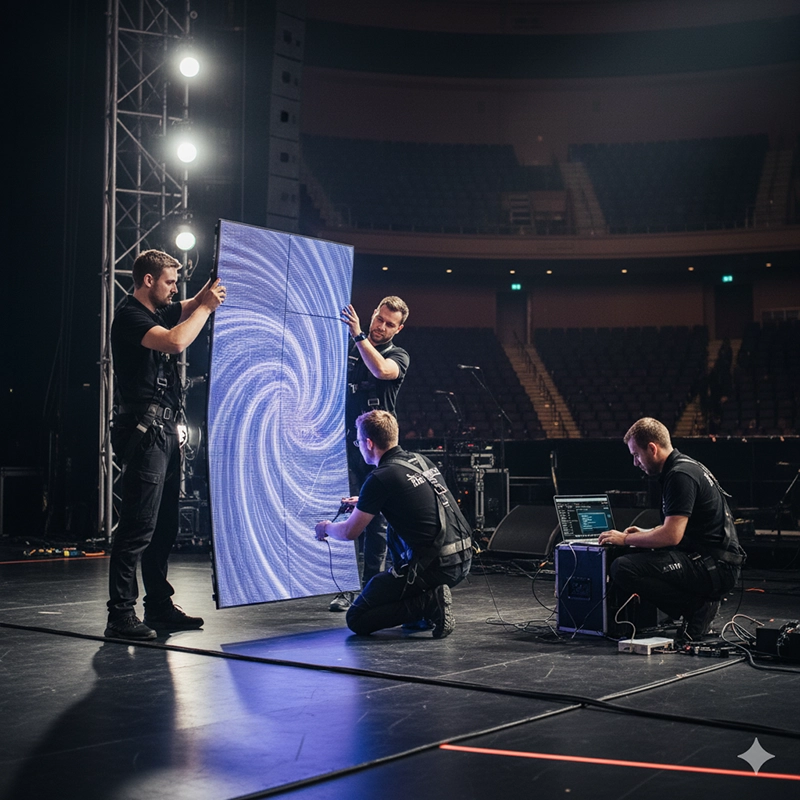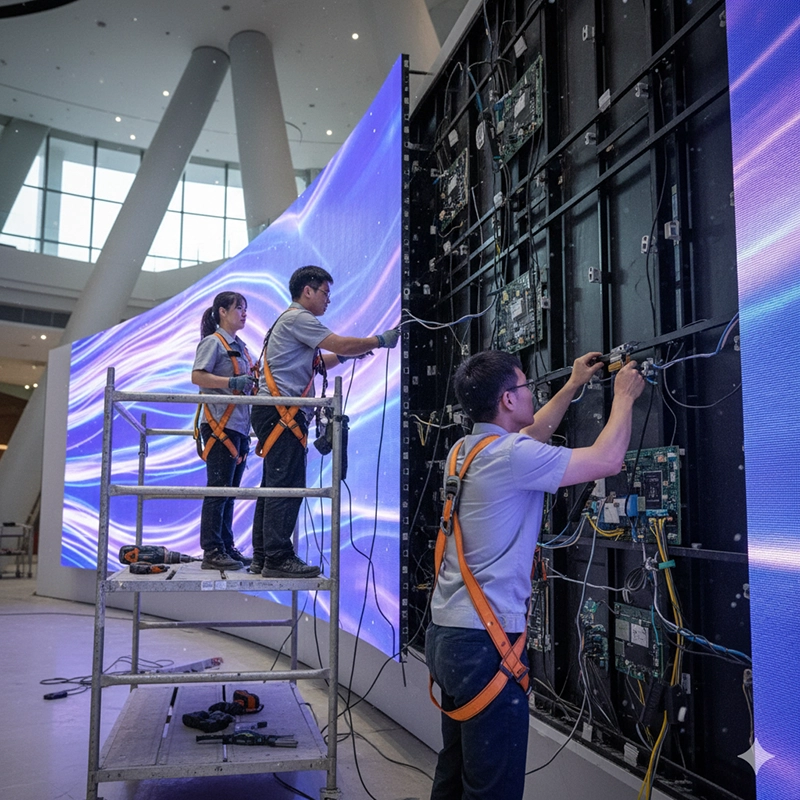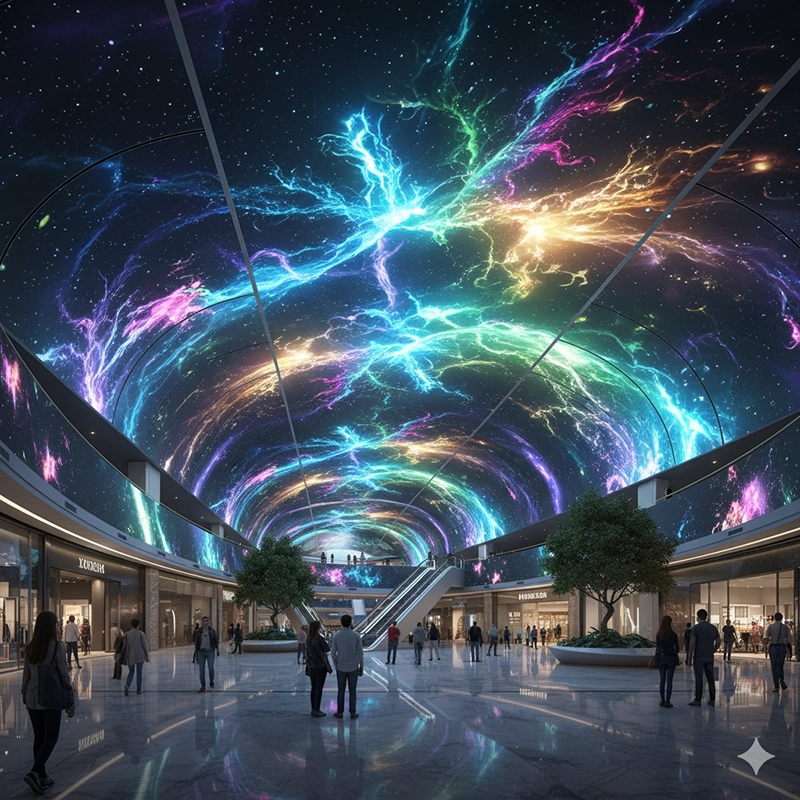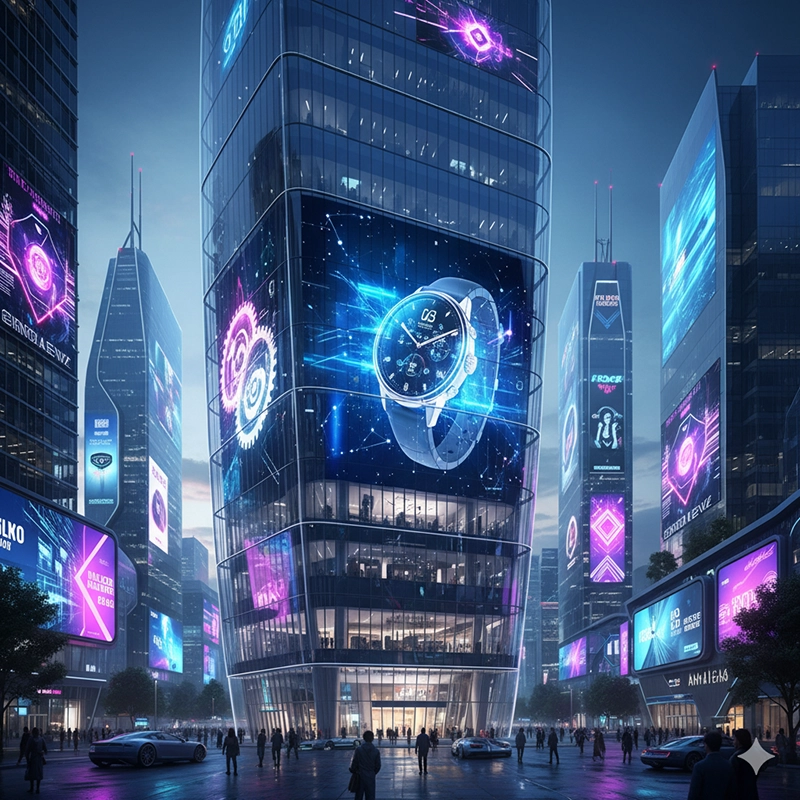Flexible LED screens represent one of the most significant innovations in the display industry, enabling curved, foldable, and customized installations that expand creative possibilities for designers, advertisers, and architects. Unlike rigid displays, flexible LED technology allows thin, lightweight, and bendable panels to fit into diverse environments, from retail storefronts to massive stadiums, transforming how audiences experience visual content.
Flexible LED refers to display technology built on bendable circuit boards and soft substrates, allowing panels to curve or fold without damage to internal components. These displays maintain high resolution and brightness while offering freedom of shape and form. Unlike traditional flat LED screens, flexible LED displays can wrap around pillars, curve across walls, or form cylindrical and wave-like designs.
The difference lies in the material composition and structural engineering. Flexible LEDs use lightweight, pliable materials and segmented module design, making it possible to create custom installations. This flexibility is not only aesthetic but also functional: it reduces weight, simplifies installation, and minimizes space requirements. The technology has evolved through the combination of fine pixel pitch, improved diodes, and durable substrates, providing reliability while supporting unlimited creativity.
Adaptive Materials: Built on flexible circuit boards and plastic substrates, allowing panels to bend and twist freely.
Modular Structure: Designed with modular segments, enabling easy splicing, curved surfaces, and custom installations.
Display Performance: Maintains brightness and clarity while offering flexibility and reduced weight compared to rigid LED displays.
Shape Adaptability: Can bend, fold, and shape to fit irregular surfaces, such as curved walls and cylindrical structures.
Lightweight Design: Made with flexible materials, these panels are lighter and easier to install on complex surfaces.
Multi-Installation Options: Support for hanging, surface mounting, and integration with diverse environments.
LED Light Strips – Widely used for accent lighting in cabinets, signage, and architectural decoration.
Flexible LED Panels – Designed for large video walls and stage backdrops, suitable for public spaces and entertainment venues.
LED Tubes – Bendable tubes for artistic designs and creative installations.
LED Lamps – Durable and weather-resistant, commonly used in stage design and architectural lighting projects.
Flexible LED screens are significantly thinner than traditional panels, making them easy to mount on walls, ceilings, or irregular structures. This design advantage reduces structural load and is especially valuable in older buildings or temporary installations.
Unlike rigid LED screens, flexible versions adapt to curved or irregular spaces. They can be manufactured in custom dimensions, whether for cylindrical columns, wavy facades, or immersive tunnels. This adaptability allows designers to craft unique visual experiences.
The modular build of flexible LED panels makes them easier to assemble and replace. Damaged modules can be swapped without dismantling entire installations, reducing downtime and costs for operators.
Modern flexible LED screens integrate advanced power management systems, resulting in lower energy consumption compared to older LED or LCD technologies. This efficiency reduces long-term operating expenses, which is crucial for large-scale or continuous-use applications.
Billboards, transportation hubs, and public plazas increasingly adopt flexible LED screens for striking visual campaigns. Their ability to curve around buildings or wrap columns maximizes visibility and enhances brand impact.
Concerts, music festivals, and sports events rely on flexible LED screens to create dynamic stage backdrops. These displays support creative transitions, immersive lighting effects, and synchronized visuals that energize audiences.
Flagship stores and shopping centers use flexible LED displays to attract customers with curved storefront signage, transparent video walls, and immersive product displays. The screens enhance branding while integrating seamlessly with interior design.
Architects apply flexible LED technology for media facades, immersive corridors, and public art installations. By blending digital content with physical structures, buildings themselves become interactive communication tools.
Indoor LED Displays – Offer high-resolution visuals ideal for conference halls, control rooms, and corporate lobbies.
LED Video Walls – Create large immersive experiences in airports, shopping malls, and exhibition centers.
Church LED Displays – Support communication in worship settings, enhancing sermons and musical performances.
Outdoor LED Displays – Deliver high brightness and weather resistance for billboards, plazas, and transportation hubs.
Stadium Display Solutions – Provide scoreboards and perimeter boards that connect audiences to live sports action.
Stage LED Screens – Form dynamic backdrops for concerts, theater, and broadcast productions.
Rental LED Screens – Offer portable and easy-to-install solutions for exhibitions, product launches, and touring shows.
Transparent LED Displays – Gain popularity in retail stores and building facades, combining visibility with natural light transmission.
| Feature | Flexible LED Screens | Traditional LED Displays |
|---|---|---|
| Structure | Bendable, lightweight, thin modules | Rigid, heavy, flat panels |
| Installation | Adaptable to curves and custom shapes | Limited to flat surfaces |
| Weight | Significantly lighter | Heavier, requires strong mounts |
| Maintenance | Easy module replacement | More complex repairs |
| Applications | Creative design, immersive projects | Standard signage and screens |
Global demand for flexible LED screens continues to rise. According to industry analyses, the LED display market is projected to grow steadily, with flexible displays gaining strong growth in entertainment and retail sectors. Market watchers predict increasing adoption in Asia-Pacific and North America due to demand for immersive advertising and digital experiences.
Innovations include the integration of Mini and Micro LED technology with flexible substrates, improving brightness, durability, and energy efficiency. Transparent and rollable LED screens are also emerging, enabling futuristic retail storefronts and transport displays. Interactive LED walls with touch and sensor capabilities are set to expand user engagement in museums, exhibitions, and experiential marketing.
Selecting an experienced manufacturer ensures product reliability, compliance with safety standards, and access to after-sales support. International buyers often seek suppliers with ISO-certified production facilities and proven OEM/ODM services.
Flexible LED screens present OEM and ODM possibilities, allowing branding customization and tailored specifications for distributors and project contractors. This model supports differentiation and local market competitiveness.
Cost depends on pixel pitch, screen size, curvature, brightness level, and durability standards. While flexible LED displays may cost more initially than rigid screens, long-term ROI is achieved through energy savings, longer life span, and higher audience engagement.
Procurement teams must evaluate warranty periods, spare parts availability, and logistical support. Reliable suppliers provide comprehensive service packages, minimizing downtime and ensuring continuity for large-scale installations.
Flexible LED screens stand out for their versatility, creative potential, and business value. Their ability to transform conventional spaces into immersive environments positions them as the leading choice for future display solutions. Industry insights from international associations indicate a clear shift toward flexible and transparent LED applications across commercial and cultural spaces. For advertisers, these screens increase engagement and ROI. For stage designers, they provide creative freedom. For retailers and architects, they blend digital storytelling with spatial design. As technology advances and costs decline, flexible LED screens are expected to dominate both indoor and outdoor installations, shaping the next era of digital communication.
Hot Recommendations
Hot Products
Get a Free Quote Instantly!
Talk to Our Sales Team Now.
If you are interested in our products, please contact us promptly
Reach out to our sales team to explore customized solutions that perfectly meet your business needs and address any questions you may have.
Email Address:info@reissopto.comFactory Address:Building 6, Huike Flat Panel Display Industrial Park, No. 1, Gongye 2nd Road, Shiyan Shilong Community, Bao'an District, Shenzhen city , China
whatsapp:+8615217757270